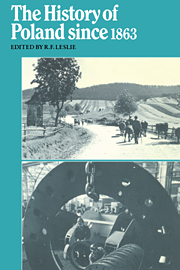Book contents
- Frontmatter
- Contents
- List of maps
- Preface to the paperback edition
- Abbreviations
- Map 1 Poland in the nineteenth century
- 1 Triloyalism and the national revival
- 2 Poland and the crisis of 1900–7
- 3 Poland on the eve of the First World War
- 4 The emergence of an independent Polish state
- 5 The breakdown of parliamentary government
- 6 Piłsudski in power, 1926–35
- 7 Poland without Piłsudski
- 8 Poland in defeat, September 1939–July 1941
- 9 The ill-fated alliance, August 1941–April 1943
- 10 The years of Tempest, May 1943–December 1944
- 11 Post-war Poland
- 12 The rise and ebb of stalinism
- 13 The October turning point
- 14 ‘The little stabilization’
- 15 The decline of Gomułka
- 16 Poland under Gierek
- 17 Polish society, 1945–75
- Epilogue: The rise and fall of Solidarity
- Notes
- Select bibliography
- Index
9 - The ill-fated alliance, August 1941–April 1943
Published online by Cambridge University Press: 26 December 2009
- Frontmatter
- Contents
- List of maps
- Preface to the paperback edition
- Abbreviations
- Map 1 Poland in the nineteenth century
- 1 Triloyalism and the national revival
- 2 Poland and the crisis of 1900–7
- 3 Poland on the eve of the First World War
- 4 The emergence of an independent Polish state
- 5 The breakdown of parliamentary government
- 6 Piłsudski in power, 1926–35
- 7 Poland without Piłsudski
- 8 Poland in defeat, September 1939–July 1941
- 9 The ill-fated alliance, August 1941–April 1943
- 10 The years of Tempest, May 1943–December 1944
- 11 Post-war Poland
- 12 The rise and ebb of stalinism
- 13 The October turning point
- 14 ‘The little stabilization’
- 15 The decline of Gomułka
- 16 Poland under Gierek
- 17 Polish society, 1945–75
- Epilogue: The rise and fall of Solidarity
- Notes
- Select bibliography
- Index
Summary
The uneasy partnership: Sikorski, Anders and Stalin
In spite of the conclusion of the Soviet–Polish pact acute problems bedevilled co-operation. Serious arguments arose connected with the size, equipment and deployment of the Polish army in Russia under General Władysław Anders, which led finally to its withdrawal to the Middle East in the summer of 1942 in an atmosphere of mutual recrimination. The evacuation of the Polish army was a severe blow to the alliance. Sikorski originally intended that Anders' troops should eventually enter Poland together with the Red Army. Indeed it would have been a political asset of great importance if the former were to occupy Poland and re-establish the organs of the civil administration in the name of the Polish state and owing allegiance to the government-in-exile in London, but now this advantage was thrown away. A second cause of conflict was the question of about 8,000 officers captured by the Soviet forces in 1939, whose disappearance Stalin could not explain. To this problem was added dispute about the citizenship of all persons of Polish nationality domiciled in the territories annexed by the USSR in 1939. The main bone of contention, however, was the unresolved frontier dispute. Sikorski visited Moscow in December 1941, when Stalin suggested to him that an agreement might be reached, but Sikorski declined to discuss the matter. The conversation with Stalin on 3 December of Sikorski, Anders and the ambassador, Stanisław Kot, was soured by Sikorski's proposal to remove the Polish army to the Middle East.
- Type
- Chapter
- Information
- The History of Poland Since 1863 , pp. 227 - 245Publisher: Cambridge University PressPrint publication year: 1980



